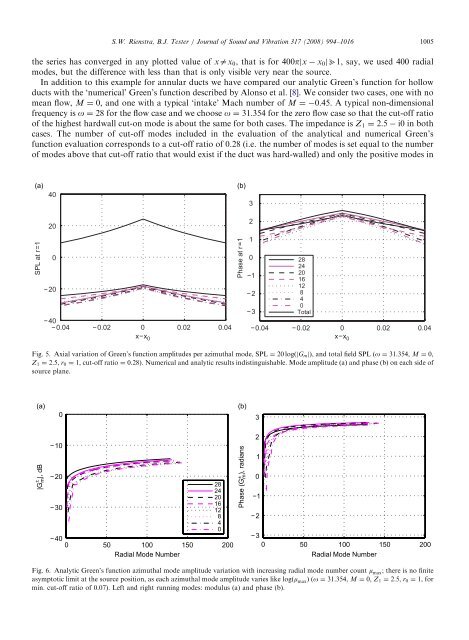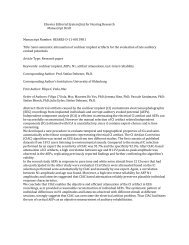An analytic Green's function for a lined circular duct containing ...
An analytic Green's function for a lined circular duct containing ...
An analytic Green's function for a lined circular duct containing ...
Create successful ePaper yourself
Turn your PDF publications into a flip-book with our unique Google optimized e-Paper software.
ARTICLE IN PRESS<br />
the series has converged in any plotted value of xax0, that is <strong>for</strong> 400pjx x0jb1, say, we used 400 radial<br />
modes, but the difference with less than that is only visible very near the source.<br />
In addition to this example <strong>for</strong> annular <strong>duct</strong>s we have compared our <strong>analytic</strong> Green’s <strong>function</strong> <strong>for</strong> hollow<br />
<strong>duct</strong>s with the ‘numerical’ Green’s <strong>function</strong> described by Alonso et al. [8]. We consider two cases, one with no<br />
mean flow, M ¼ 0, and one with a typical ‘intake’ Mach number of M ¼ 0:45. A typical non-dimensional<br />
frequency is o ¼ 28 <strong>for</strong> the flow case and we choose o ¼ 31:354 <strong>for</strong> the zero flow case so that the cut-off ratio<br />
of the highest hardwall cut-on mode is about the same <strong>for</strong> both cases. The impedance is Z1 ¼ 2:5 i0 in both<br />
cases. The number of cut-off modes included in the evaluation of the <strong>analytic</strong>al and numerical Green’s<br />
<strong>function</strong> evaluation corresponds to a cut-off ratio of 0.28 (i.e. the number of modes is set equal to the number<br />
of modes above that cut-off ratio that would exist if the <strong>duct</strong> was hard-walled) and only the positive modes in<br />
SPL at r=1<br />
40<br />
20<br />
0<br />
−20<br />
−40<br />
−0.04 −0.02 0<br />
x−x0 0.02 0.04<br />
Phase at r=1<br />
3<br />
2<br />
1<br />
0<br />
−1<br />
−2<br />
−3<br />
28<br />
24<br />
20<br />
16<br />
12<br />
8<br />
4<br />
0<br />
Total<br />
−0.04 −0.02 0<br />
x−x0 0.02 0.04<br />
Fig. 5. Axial variation of Green’s <strong>function</strong> amplitudes per azimuthal mode, SPL ¼ 20 logðjGmjÞ, and total field SPL (o ¼ 31:354, M ¼ 0,<br />
Z1 ¼ 2:5, r0 ¼ 1, cut-off ratio ¼ 0:28). Numerical and <strong>analytic</strong> results indistinguishable. Mode amplitude (a) and phase (b) on each side of<br />
source plane.<br />
±<br />
|Gm |, dB<br />
0<br />
−10<br />
S.W. Rienstra, B.J. Tester / Journal of Sound and Vibration 317 (2008) 994–1016 1005<br />
−20<br />
−30<br />
−40<br />
28<br />
24<br />
20<br />
16<br />
12<br />
8<br />
4<br />
0<br />
0 50 100<br />
Radial Mode Number<br />
150 200<br />
Phase (G± m ), radians<br />
3<br />
2<br />
1<br />
0<br />
−1<br />
−2<br />
−3<br />
0 50 100<br />
Radial Mode Number<br />
150 200<br />
Fig. 6. <strong>An</strong>alytic Green’s <strong>function</strong> azimuthal mode amplitude variation with increasing radial mode number count m max; there is no finite<br />
asymptotic limit at the source position, as each azimuthal mode amplitude varies like logðm maxÞ (o ¼ 31:354, M ¼ 0, Z1 ¼ 2:5, r0 ¼ 1, <strong>for</strong><br />
min. cut-off ratio of 0.07). Left and right running modes: modulus (a) and phase (b).
















